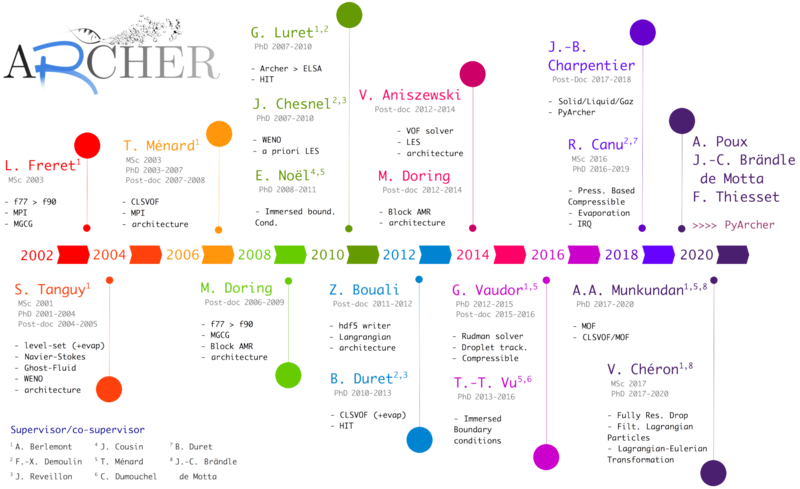Archer
Contents
General Overview
Scope
ARCHER is a High-Performance-Computing code developed at the CORIA laboratory. It stands for Academic Research Code for Hydrodynamic Equations Resolution. It also takes its name from the fish, the Archerfish (Toxotidae), known for preying insects by spitting a jet of water.
Archer is aimed at carrying Direct Numerical Simulations of two-phase flows may they be turbulent, incompressible or compressible, with phase change or in presence of solid boundaries. Data from Archer are used for probing the physical properties (either geometrical, morphological, topological, or dynamical) of different phenomena such as atomization, spray formation, dispersion, evaporation, phase separation, capture of solid aerosols. The close connection of the Archer developers with experimentalist is further noticeable. This wide knowledge serves for building or reinforcing physics-informed models, notably the Eulerian Lagragian Spray Atomization model (ELSA).
It was one of the first code worldwide, undertaking the simulation of liquid-jet atomization under a realistic injection configuration.
History
The Archer project took shape in 2001 thanks to the impulsion of Alain Berlemont who supervised the first two PhDs (S. Tanguy 2001-2004, T. Ménard 2003-2007), sparking the first developments of the code. Since then, 11 PhD students, 7 post-doctorates and many Master students have contributed to its progress. It now constitutes a compulsory tool for many researchers of the CORIA laboratory (A. Berlemont, T. Ménard, P. Desjonqueres, J. Cousin, F-X. Demoulin, J. Reveillon, B. Duret, A. Poux, J.C.B. de Motta, F. Thiesset, C. Dumouchel) and is involved in many projects funded by either national (ANR) or international (Marie-Curie ITN) agencies.
The chart below retraces the main steps of the Archer project.
Brief description
ARCHER solves on a staggered Cartesian mesh the one-fluid formulation of the incompressible Navier-Stokes equation. In this objective, the convective term is written in conservative form and solved using an improved Rudman’s technique. The latter allows mass and momentum to be transported in a consistent manner thereby enabling flows with large liquid/gas density ratios to be simulated accurately. To ensure incompressibility of the velocity field, a Poisson equation is solved. The latter accounts for the surface tension force and is solved using a MultiGrid preconditioned Conjugate Gradient algorithm (MGCG) coupled with a Ghost-Fluid method.
For transporting the interface, use is made of a coupled level-set and volume-of-fluid (CLSVOF) solver, in which the level-set function accurately describes the geometric features of the interface (its normal and curvature) and the volume-of-fluid function ensures mass conservation. The density is calculated from the volume-of-fluid. The dynamic viscosity depends on the sign of the level-set function. In cells containing both a liquid and gas phase, a specific treatment is performed to evaluate the dynamic viscosity.
Current work is targeting compressible flow, evaporation, lagrangian particles.
ARCHER is written in Fortran+MPI and PyArcher is a Python (Dask+Xarray) library written to pre/post process data for ARCHER.

